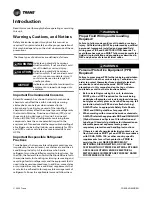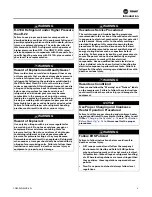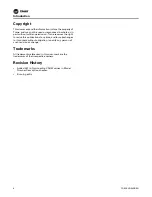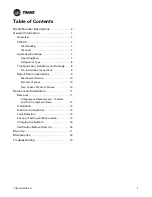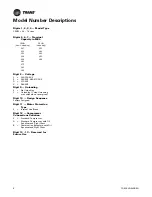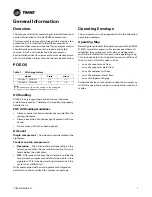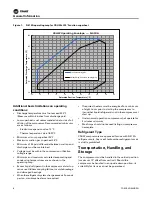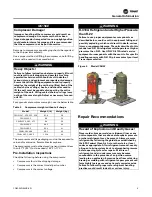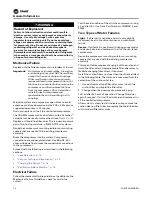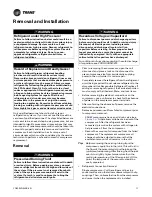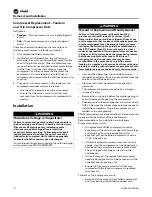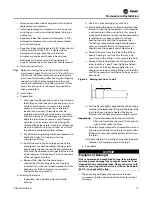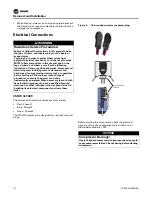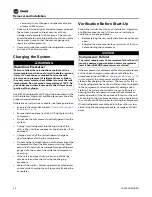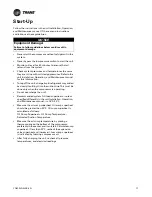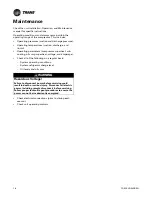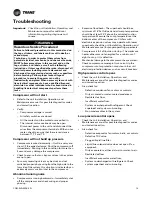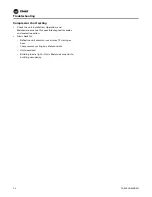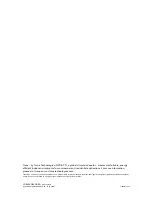
Removal and Installation
12
COM-SVN003B-EN
Compressor Replacement—Tandem
and Trio Compressor Sets
Definitions:
•
Tandem
—Two compressors on a single refrigerant
circuit.
•
Trio
—Three compressors on a single refrigerant
circuit.
There are special considerations that are unique to
replacing compressors in a tandem or trio set:
1. Only replace the failed compressor.
2. On tandem or trio assemblies, the suction and
discharge lines must not be modified, except for the
use of slip-joint couplings. Other modifications may
cause oil return issues and lead to compressor failure.
Cut the lines in a convenient place, remove the
compressor, and then unbraze the lines from the
compressor. On re-installation, reinstall lines to
compressor and reassemble the cut lines using a slip
coupling.
3. Change oil in all compressors in the tandem or trio
compressors whenever there is a failure.
•
Use the oil charging valve on the compressor.
•
Ensure that the same amount of oil that was
removed from the compressors is replaced with
new oil.
Installation
•
Only qualified personnel should install or repair
refrigeration systems. If you are not qualified, seek the
services of qualified personnel.
•
Pressure tests must be performed by qualified
personnel.
•
The replacement compressor contains a nitrogen
charge of 5 psig.
•
Remove the suction plug before the discharge plug to
avoid oil spray while opening the compressor.
•
Keep exposure to the atmosphere at a minimum due to
POE oil. Remove the rubber plugs only when ready to
install the compressor. Plug other compressor on
tandem or trio compressors.
CSHW compressors are shipped with oil; the level should
be equal with the bottom of the equalizer port.
Recommendations for installation are as follows:
Single compressor circuit:
•
All replacement CSHW compressors have an
equalizer port (closed with a rubber plug for storage
and shipping). For single applications, this
equalizer port will need to be brazed shut with a
1.125" tube and cap.
•
If the replacement compressor requires a full oil
charge, then the compressor can be tipped away
from equalizer port while the port is brazed shut.
The as-shipped oil charge can remain in the
compressor.
•
If the oil charge in the replacement compressor
needs to be reduced, oil can be poured out of the
equalizer prior to brazing shut.
•
Ensure that the same amount of oil that was
removed with the failed compressor is replaced
with new oil.
Tandem or Trio compressor circuit:
•
Remove and measure oil from failed compressor
and from existing manifolded compressor(s).
WARNING
Hazardous Voltage w/Capacitors!
Failure to disconnect power and discharge capacitors
before servicing could result in death or serious injury.
Disconnect all electric power, including remote
disconnects and discharge all motor start/run
capacitors before servicing. Follow proper lockout/
tagout procedures to ensure the power cannot be
inadvertently energized. Verify with an appropriate
voltmeter that all capacitors have discharged.
For additional information regarding the safe discharge
of capacitors, see PROD-SVB06*-EN.
WARNING
Hazard of Explosion and Deadly Gases!
Failure to follow all proper refrigerant handling
practices could result in death or serious injury.
Never solder, braze or weld on refrigerant lines or any
unit components that are above atmospheric pressure
or where refrigerant may be present. Always remove
refrigerant by following the guidelines established by
the EPA Federal Clean Air Act or other state or local
codes as appropriate. After refrigerant removal, use dry
nitrogen to bring system back to atmospheric pressure
before opening system for repairs. Mixtures of
refrigerants and air under pressure may become
combustible in the presence of an ignition source
leading to an explosion. Excessive heat from soldering,
brazing or welding with refrigerant vapors present can
form highly toxic gases and extremely corrosive acids.


